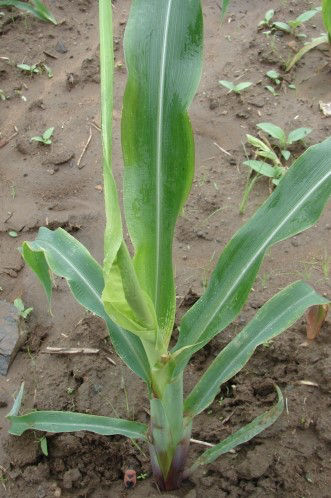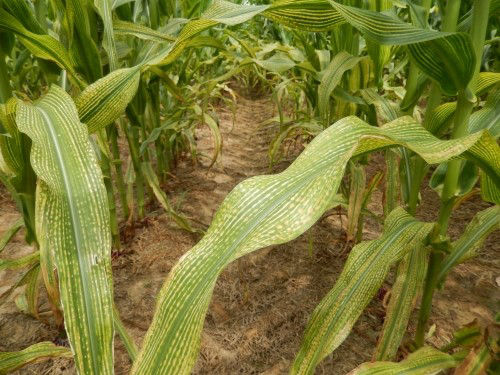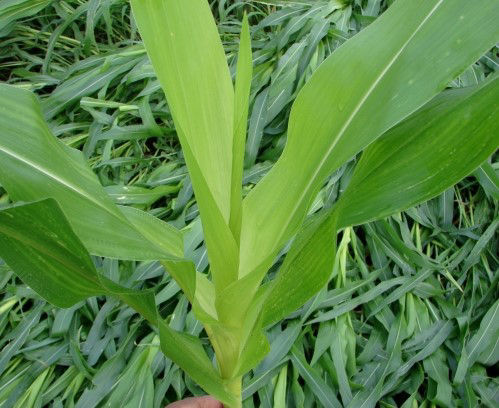5 MIN READ
Benefits of Secondary Macronutrients for Corn Production
October 30, 2019
Introduction
Calcium (Ca), magnesium (Mg), and sulfur (S) are essential plant nutrients for corn production. They are called secondary macronutrients because plants require them in smaller amounts than primary macronutrients (nitrogen, phosphorus, and potassium). Long-term cropping practices have removed measurable amounts of these nutrients from the soil. Consequently, secondary macronutrient deficiencies are becoming an increasingly important factor in intensive corn production systems, especially in soils fertilized only with primary macronutrients.
Calcium
Calcium is an integral part of plant cell walls. Without adequate Ca, cell walls can collapse and plants would not remain upright. Ca helps improve the absorption of other nutrients by roots and their translocation in plants, and it can help improve disease resistance in plants. The nutrient contributes to soil fertility by maintaining a favorable soil pH, and it has a positive effect on soil properties. It improves soil structure thereby increasing water penetration and providing a more favorable soil environment for growth of plant roots and soil microorganisms.
Calcium exists in mineral soils as the Ca2+ divalent cation which can be taken up by plants. When soil is limed to maintain an optimum pH level, there is usually adequate Ca available for the crop. Soil tests can estimate available Ca by measuring the cation on the soil CEC (cation exchange capacity).
Calcium deficiency is most likely to occur in acid, sandy soils from which Ca has been leached by rain or irrigation water. It may also occur in strongly acid peat and muck soils where total Ca is low. It is not likely to occur when soil is properly limed to adjust soil pH to optimum levels for corn production. Deficiency symptoms on corn show new leaves failing to emerge from the whorl because of a sticky, gelatinous material on the edges of the leaves. Symptoms appear on the new leaf growth since Ca is immobile within the plant. Young leaves can become distorted and small, the leaf margins often irregular, with spotted or necrotic areas and chlorotic leaf tips (Figure 1). Ca deficiency can be prevented by soil testing on a regular basis and correcting soil acidity with proper liming.

Magnesium
Magnesium is a component of the chlorophyll molecule and is essential for photosynthesis. It is also a phosphorus carrier in plants. Plants without Mg would not be able to take up phosphorus. It is essential for phosphate metabolism, plant respiration, and the activation of enzyme systems in plants.
Magnesium is taken up by the plant as the Mg2+ divalent cation. As Mg-containing minerals in the soil slowly weather, some Mg is made available to plants. The supply of available Mg can be lost or deleted through leaching, plant uptake and removal processes. The availability of Mg to plants is often related to soil pH, with supply decreasing in both low and high pH soils. Soil tests can estimate available Mg by measuring the cation on the soil CEC.
Magnesium deficiency in corn is characterized as interveinal chlorosis. The loss of a healthy green color can be the first indication of deficiency. Since Mg is mobile in plants, older leaves are affected first. As the deficiency becomes more severe, the area between the veins of the leaves becomes yellow while the veins stay green (Figure 2). To correct for Mg deficiency in the soil, dolomitic limestone can be applied broadcast before planting. Soluble sources of Mg can also be provided in fertilizer. Irrigation water can contain a substantial amount of Mg which is readily available to the crop. Small amounts of Mg can be applied through foliar fertilizer to correct or prevent developing deficiencies, but the preferred approach is to soil-apply the required amounts before planting.

Sulfur
Corn requires greater amounts of S because it is a high dry-matter production crop. Sulfur is essential in plants for protein synthesis, chlorophyll development, and photosynthesis. The nutrient is often overlooked in many soil fertility programs and has become an increasing limitation to corn production due to expanding yields.
Most of the S in soil is bound by organic matter and cannot be used by plants until it is converted to soluble sulfate (SO4-2) by soil bacteria through the process of mineralization. Sulfate is mobile in the soil and can easily leach with rainfall or irrigation. Sandy soils that are low in organic matter and clay particles are more likely to be deficient in S.
Sulfur deficiency symptoms are often confused with nitrogen deficiency. Both deficiencies can appear as stunted plants with a general yellowing of leaves. Since S is immobile in the plant, deficiency symptoms first appear in younger leaves (Figure 3). In contrast, nitrogen deficiency symptoms first appear on the older leaves. Sulfur deficiencies have become more common with continued use of high analysis fertilizers with little or no S and reduced deposition of atmospheric S with efforts to reduce acid rain.
Rainfall and irrigation water can supply a significant amount of S. Air pollution abatement efforts have reduced S emissions from industry and decreased the amount of S added to the soil by precipitation. Sulfur can also be provided through application of manure and fertilizers. Most fertilizer sources of S are sulfates (ammonium sulfate and calcium sulfate) that are moderately to highly soluble in water. Corn can respond to supplemental S on sandy soils low in organic matter. There is generally not a response to supplemental S applied to fine-medium textured soils with organic matter greater than 2%. Sulfur can be included in preplant or starter fertilizers. Plant analysis is the best tool for monitoring S in the crop as soil tests are not very reliable.

Related Article
Benefits of Micronutrients for Corn Production
Sources
Beegle, D. 2013. Soil Fertility Management. The Agronomy Guide. Penn State University.
Oldham, L. 2019. Secondary plant nutrients: calcium, magnesium, and sulfur. Mississippi State University information sheet 1039. http://extension.msstate.edu.
Vitosh, M. 2015. Secondary and micronutrients for vegetable and field crops. Michigan State University Extension publication E486. https://www.canr.msu.edu.
Johnston, A. and Dowbenko, R. Essential elements in corn. Farmwest. https://farmwest.com.
Web sources verified 10/7/19.
1011_S4






